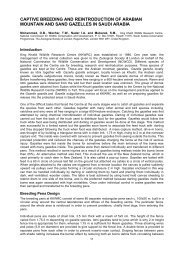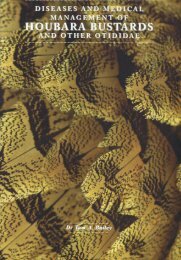His Highness Sheikh Zayed bin Sultan Al Nahyan - Wildlife Middle ...
His Highness Sheikh Zayed bin Sultan Al Nahyan - Wildlife Middle ...
His Highness Sheikh Zayed bin Sultan Al Nahyan - Wildlife Middle ...
Create successful ePaper yourself
Turn your PDF publications into a flip-book with our unique Google optimized e-Paper software.
disappeared from the forests along the Urals and Emba<br />
rivers, where it was numerous (Dementiev and Gladkov<br />
1951). The Sakers of the Mugodzhary range had a similar<br />
fate, despite the fact that in 1940-50s it was considered as<br />
the only tree-less area with breeding sakers (Dementiev and<br />
Gladkov 1951). It is worth noting that the catastrophic<br />
decline was experienced by a population that is truly<br />
migratory, and thus are more susceptible to various threats.<br />
<strong>Al</strong>so it is possible to hypothesise that the Sakers were badly<br />
influenced by overgrowing of the steppe and desert plants<br />
reacting to lack of grazing. The latter happened in large<br />
areas as a reaction of the collapse of animal husbandry in<br />
Kazakhstan in 90s. The collapse made the border between<br />
steppe and semi-desert biome to shift far south. Tall grass is<br />
also susceptible to fires and re-emergence of pyrogenic<br />
communities resulting in a decline of the sousliks and<br />
gerbils – the food base of the Saker. Indirectly this<br />
hypothesis could be supported by the fact that in lowgrazing<br />
areas the numbers of Steppe and Imperial Eagles is<br />
lower than in the high-grazing areas.<br />
So, internationally the problem is illegal<br />
smuggling; domestically, changes of traditional grazing<br />
levels. If the first problem has been addressed by the<br />
International bodies such as CITES and is recognised by the<br />
Kazakhstan Government, the second problem is not<br />
recognised and is largely unsolved.<br />
The authors thank Andrey Semenov for his<br />
contribution in transportation, Ilya Smelyanskiy and<br />
Andrey Korolyk for help in the field, and the Falcon<br />
Research Institute, IWC/ERWDA for financial help.<br />
Diagnostic Investigation of Vulture Mortality:<br />
The Anti-inflammatory Drug Diclofenac is<br />
Associated with Visceral Gout<br />
J. Lindsay Oaks1, Carol U. Meteyer2, Bruce A. Rideout3, H.L. Shivaprasad4, Martin Gilbert5, Munir Z. Virani5, Richard T. Watson5 and <strong>Al</strong>eem Ahmed Khan6 1Department of Veterinary Microbiology and Pathology,<br />
Washington State University, Pullman, WA 99164-7040,<br />
USA<br />
2U.S.G.S., National <strong>Wildlife</strong> Health Center, 6006<br />
Schroeder Road, Madison, WI 53711-6223, USA<br />
3Center for Reproduction of Endangered Species,<br />
Zoological Society of San Diego, PO Box 120551, San<br />
Diego, CA 92112-0551, USA<br />
4California Animal Health and Food Safety Laboratory<br />
System – Fresno Branch, Univeristy of California at<br />
Davis, 2789 S. Orange Avenue, Fresno, CA 93725, USA<br />
5The Peregrine Fund, 5668 West Flying Hawk Lane,<br />
Boise, ID 83709, USA<br />
6Ornithological Society of Pakistan, 109/D PO Box 73,<br />
Dera Ghazi Khan, Pakistan<br />
Since 2000, white-backed vultures (Gyps<br />
bengalensis) in the Punjab Province of Pakistan have<br />
experienced significant population declines due to high<br />
mortality rates associated with the clinical syndrome of<br />
13<br />
References<br />
Bragin E.A. 2001. Recent status and studies of the Saker<br />
Falcon in the Northern Kazakhstan. – Proc. of the<br />
II International Conf. on the Saker Falcon and<br />
Houbara Bustard, Mongolia, 1-4 July 2000.<br />
Ulaanbaatar. P. 110-115.<br />
Dementiev G.P. and Gladkov V. 1951. Birds of the USSR.<br />
V. 1. Sovetskaya Nauka publishers. 652 pp.<br />
Fox, N. Barton, N. and Potapov, E. 2003. Conservation of<br />
Saker and falconry. Steppe bulletin 14: 28-33.<br />
Gu<strong>bin</strong>, B. 2002. Saker (Falco cherrug). Kazakhstan<br />
ornithological Bulletin. <strong>Al</strong>maty, Tethys: 69.<br />
Karyakin I. 2003. Saker in the <strong>Al</strong>tay-Sayan region: results<br />
of 2003. Steppe Bulletin 14: 34-35.<br />
Karyakin I., Konovalov L., Moshkin A., Pazhenkov A.,<br />
Smelyanskiy I., Rybenko A. 2004. Saker Falcon<br />
(Falco cherrug) in Russia. – Falco. 23. P. 3-9.<br />
Karyakin, I. 2004a. Saker in the Usturt Plateau: brief results<br />
of the expedition of 2003. Steppe Bulletin 15: 40-<br />
41.<br />
Karyakin I. 2004b. Saker in the Volga-Ural region and<br />
adjoining territories. Steppe Bulletin 15: 40-41.<br />
Levin A.S. 2001. On the critical state of the Saker Falcon<br />
population in Kazakhstan. – Proc. of the II<br />
International Conf. on the Saker Falcon and<br />
Houbara Bustard, Mongolia, 1-4 July 2000.<br />
Ulaanbaatar. P. 64-79.<br />
visceral gout (Gilbert et al., 2004; Gilbert et al., 2002).<br />
<strong>His</strong>topathology has shown that the visceral gout is due to<br />
acute kidney failure in which the lesions were primarily<br />
characterized as severe, acute tubular necrosis, with<br />
minimal inflammatory infiltrates. These lesions are most<br />
compatible with an acute toxic etiology.<br />
Toxicologic investigations ruled out toxic levels of<br />
heavy metals known to be associated with renal failure in<br />
birds, including cadmium, lead and mercury (Furness, 1996<br />
Pain 1996; Thompson 1996). <strong>Al</strong>though not classically<br />
recognized as nephrotoxic, toxic or deficient levels of other<br />
heavy metals, including arsenic, copper, iron, manganese,<br />
molybdenum and zinc also were not detected. Similarly,<br />
there was no evidence of acute intoxication by<br />
organophosphate, carbamate, or organochlorine pesticides.<br />
Virus isolation results were negative. Molecular biology<br />
(PCR) studies for avian influenza and infectious bronchitis<br />
virus, two viruses recognized as renal pathogens in poultry<br />
(Swayne 1994; Ziegler 2002) were negative.<br />
With the exclusion of known causes of renal<br />
disease and/or acute death in birds, the studies were directed<br />
at novel toxins. Since the primary food source for the<br />
vultures in Pakistan are domestic livestock, we




